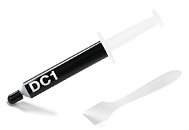- Joined
- Oct 9, 2007
- Messages
- 47,677 (7.43/day)
- Location
- Dublin, Ireland
| System Name | RBMK-1000 |
|---|---|
| Processor | AMD Ryzen 7 5700G |
| Motherboard | Gigabyte B550 AORUS Elite V2 |
| Cooling | DeepCool Gammax L240 V2 |
| Memory | 2x 16GB DDR4-3200 |
| Video Card(s) | Galax RTX 4070 Ti EX |
| Storage | Samsung 990 1TB |
| Display(s) | BenQ 1440p 60 Hz 27-inch |
| Case | Corsair Carbide 100R |
| Audio Device(s) | ASUS SupremeFX S1220A |
| Power Supply | Cooler Master MWE Gold 650W |
| Mouse | ASUS ROG Strix Impact |
| Keyboard | Gamdias Hermes E2 |
| Software | Windows 11 Pro |
be quiet!, market leader for power supplies in Germany for seven years in a row*, announced today the availability of the new high performance thermal compound DC1. The new paste is the logical extension of the award-winning cooler portfolio of the German company. With its excellent heat conducting properties and its extremely simple handling, the paste is suitable for both normal users and Overclockers.
Through the perfect combination of metal oxides and silicon the new be quiet! thermal compound DC1 has a theoretical thermal conductivity of about 7.5 W / mK. Thus it offers several degrees Celsius advantage over conventional thermal compounds, as used for example in many ready-build-systems. Overclockers can also improve their results with the DC1. Thanks to a wide temperature range of -50 to +150 ° C, DC1 is suitable for various cooling methods.


Its unique composition allows the paste to be applied easily. be quiet! 's DC1 comes in a handy syringe, which allows for a neat and tidy application onto the CPU die. For a perfect and planar layer of thermal compound there is an extra enclosed spatula. A syringe with 3 grams of be quiet!'s DC1 costs EUR 6.49 and is available in stores now.

View at TechPowerUp Main Site
Through the perfect combination of metal oxides and silicon the new be quiet! thermal compound DC1 has a theoretical thermal conductivity of about 7.5 W / mK. Thus it offers several degrees Celsius advantage over conventional thermal compounds, as used for example in many ready-build-systems. Overclockers can also improve their results with the DC1. Thanks to a wide temperature range of -50 to +150 ° C, DC1 is suitable for various cooling methods.


Its unique composition allows the paste to be applied easily. be quiet! 's DC1 comes in a handy syringe, which allows for a neat and tidy application onto the CPU die. For a perfect and planar layer of thermal compound there is an extra enclosed spatula. A syringe with 3 grams of be quiet!'s DC1 costs EUR 6.49 and is available in stores now.

View at TechPowerUp Main Site



